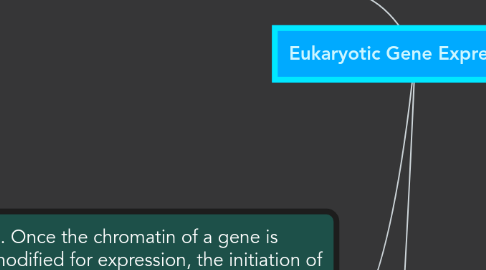
1. 1. Chromatin-modifying enzyme provide initial control of gene expression by making a region of DNA more or less able to bind the transcription machinery
1.1. Histone Modifications - can influence both chromatin structure and gene expression
1.1.1. Histone Acetylation - acetyl groups are attached to lysines in histone tails
1.1.1.1. When lysines are acetlated, thier postive changes are neutralized and the histone tails no longer bind to neighboring nucleosomes. As a result, transcription proteins have easier acess to genes in an acetyled region.
1.1.2. Histone Methylation - the addition of methyl groups to histone tails
1.1.2.1. This can promote condensation of the chromatin. In contrast to histone acetylation, histone methylation promotes condensed chromatin structure that hinders transcription.
2. 2. Once the chromatin of a gene is modified for expression, the initiation of transcription is the next major step at which gene expression is regulated.
2.1. Control Elements - segments of noncoding DNA that help regulate transcription by binding certain proteins
2.1.1. Proximal Control Elements - located close to the promoter
2.1.2. Distal Control Elements -groupings of which are called enhancers
2.1.2.1. The rate of gene expression can be strongly increased or decreased by the binding of activators or repressors (specific transcription factors) to the control elements of enhancers
2.1.2.1.1. Binding of Activators - activators bind to the enhancer DNA sequences and then to a group of mediator proteins, which in turn bind to general transcription factors, assembling the transcription initiation complex
2.1.2.1.2. Binding of Repressors - some repressors bind directly to control element DNA, blocking activators or turning off transcription even when activators are bound. Other ones block the binding of activotors to proteins that allow the activators to bind to DNA
2.2. Transcription Factors - proteins needed by RNA polymerase to initiate transcription
2.2.1. General Transcription Factors - essential for the transcription of all protein-coding genes
2.2.2. Specific Transcription Factors - essential for high levels of transcription of particular genes at the appropriate time and place
3. 3. The expression of a protein-coding gene is ultimately measured by the amount of functional protein a cell makes. More regulatory mechanisms operate after transcription to fine-tune gene expression as a part of post-transcriptional regulation.
3.1. RNA Processing
3.1.1. Alternative RNA Splicing - different mRNA molecules are produced from the same primary transcript, depending on which are exons and introns
3.2. Translation
3.2.1. Translation presents another opportunity for regulating gene expression; such regulation occurs most commonly at the initiation stage. Translation of all the mRNAs in a cell may be regulated simultaneously. This involves the activation or inactivation of one or more of the protein factors required to initiation translation
3.2.1.1. The inititation of translation of some mRNAs can be blocked by regulatory proteins that bind to sepcific sequences within the untranslated regions at the 5' end of mRNA, preventing attachment of ribosomes
3.2.1.2. The initiation of translation can be triggered by the activation of translation initiation factors, promoting the synthesis of proteins encoded by the mRNAs
3.3. Post-Translation - final opportunities for controlling gene expression occur after translation
3.3.1. Protein Processing - eukaryotic polypeptides are usually processed to yield functional; molecules. Many also undergo chemical modifications that make them functional
3.3.2. Protein Degradation - the length of time each protein functions in the cell is regulated by selective degradation. Giant protein complexes called proteasome degrade proteins with ubiquitin molecules attached.
